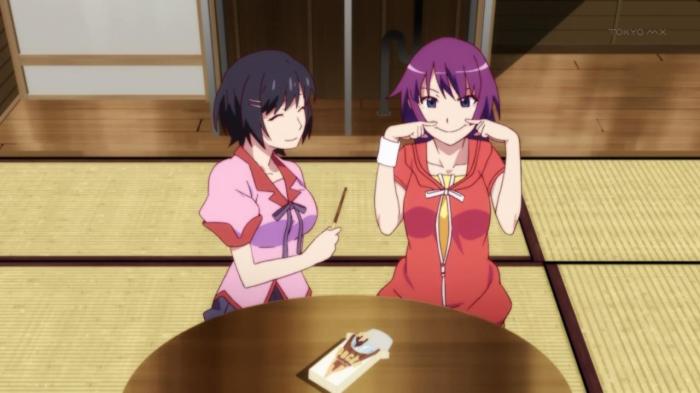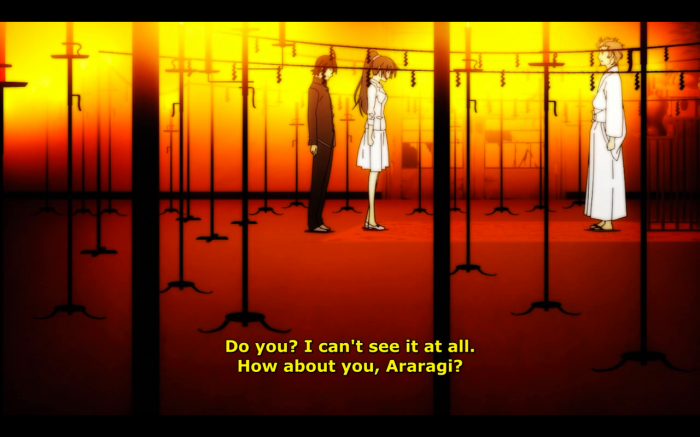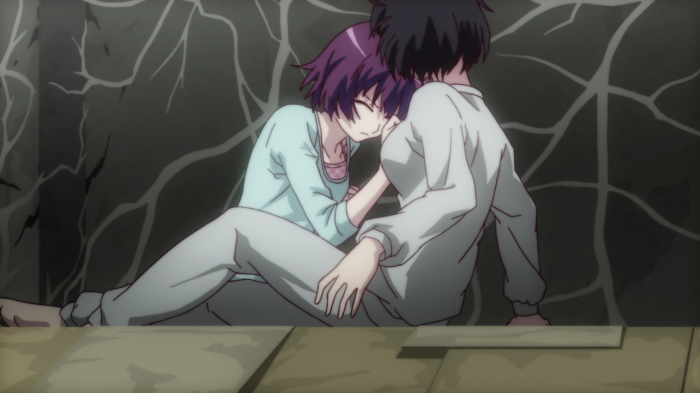Monogatari holds a very special place in my heart. When I started watching Bakemonogatari, I was having a tough time. It was the last time I watched anime as a means of escaping the world, which, for me, seemed to hold nothing but failure. Monogatari was the first anime that made me really think about what I was watching and the first that I treated the same way I would treat literature. It wasn’t a decision I made on my own, Monogatari forced me to see myself in its characters. It wasn’t straightforward assertions of ideals, which can be found in many anime, which was able to break through my shell of denial, it was Monogatari’s subtlety and incredible characters.

One thing my mother often said to me around that time, when I had effectively become a college dropout, was that there is no difference between depression and cancer. My natural response, which I did not vocalize was, “yeah, except, y’know, everything.” Of course, I could comprehend the argument my mother was making. Even though people can’t see depression and don’t really take it as seriously, the way it can interrupt your life is similar.

That’s why I had to withdraw from my studies at the University of Notre Dame. Despite my mother’s encouragement, I couldn’t not consider myself a failure, y’know? Of course, how could you expect me not to blame myself at a time when I was mired in self-hatred? My mother never told me that my situation was not my own fault. I’m glad she didn’t let me play the victim.

No matter what she said, she wasn’t going to fully convince me of her comparison between depression and cancer. Nobody purposely behaves in a way that makes them more susceptible to cancer.

Nobody finds comfort in resigning themselves to a fate determined by cancer. Nobody with cancer is content to wallow in their own pain.

Nobody with cancer would hesitate to jump at the opportunity to have their cancer cured, if one presented itself. 
Bradford Cox reflects on depression and other forms of sadness and self-hatred in the Deerhunter song, Revival. He plainly states that, “it doesn’t make much sense.” Well, ain’t that the truth? I can testify that doesn’t make much sense, having firsthand experience. I also imagine that it doesn’t make much sense to those watching their friends or family struggle with it. In fact, I know that it doesn’t make much sense to them because they’ve told me. Unless you tell people, they have no way of knowing what you’re dealing with, or that you’re dealing with anything at all. If you don’t let anybody close, the only people that will notice are those that have been there before and those that are still there.

Even those people, however, will never be able to understand. They’ll never truly be able to put themselves in your shoes, but that doesn’t mean they can’t care. Bakemonogatari’s first arc, Hitagi Crab, captures this experience perfectly in the scene of Senjougahara’s exorcism.

I’ll start with the central visual metaphor in this scene, the most concrete example of layered storytelling that I can prove without a doubt. Senjougahara’s exorcism illustrates not only the firsthand experience of struggling with your problems, it also illustrates the experience of watching others struggle with their problems. During the ritual, when Oshino is counting and questioning Senjougahara, the implied perspective shifts subtly from Araragi to Senjougahara.

Once Senjougahara has spoken about her emotional baggage and laid it all out, she is told to open her eyes and is asked what she sees. Both she and the camera are able to see the weight crab, beautifully depicted by Shaft.

Senjougahara answers, and Oshino says that he can’t see anything, and, when asked, Araragi says likewise.

Confused, Senjougahara says, “but it’s clearly visible… to me.” There’s the first layer. Our personal problems are ours alone. Even if somebody has been through a similar experience, nobody has shared in your specific struggles other than yourself.  Depression and other problems of this nature, which everybody has to deal with as they grow up, are undetectable. They lie in the mind and manifest no physical evidence of their existence, at least not through natural means. They aren’t such concrete ailments as cancer, but they are no less real. The second layer is the demonstration of that point. The crab tackles Senjougahara, sending her flying across the room and pinning her against the wall. When this happens, the camera has been returned to Araragi’s perspective, and he calls out to Senjougahara upon seeing her launched across the room by a force that remains invisible to him.
Depression and other problems of this nature, which everybody has to deal with as they grow up, are undetectable. They lie in the mind and manifest no physical evidence of their existence, at least not through natural means. They aren’t such concrete ailments as cancer, but they are no less real. The second layer is the demonstration of that point. The crab tackles Senjougahara, sending her flying across the room and pinning her against the wall. When this happens, the camera has been returned to Araragi’s perspective, and he calls out to Senjougahara upon seeing her launched across the room by a force that remains invisible to him.

Although Senjougahara’s problems can’t clearly be perceived by Araragi and Oshino, the effects that it have on her can be. With depression, one of the most outwardly obvious effects is loss of interest. When I was plunging into depression, the first thing people noticed was how much less enthusiastic I had become, how much more I was sleeping, how frequently I had started skipping classes. Even if your friends and others that surround you can’t perceive your problems in their own right, they can certainly perceive the toll that your struggle with them has taken on you. That is enough evidence for those that truly care for you to express their concern and reach out.

And, as with Senjougahara, the only way to truly deal with your problems, is to acknowledge and accept them, instead of repressing them.

Senjougahara’s exorcism is presented as a full blown religious ritual. It requires ritual cleansing of each of the participants and appropriate attire, which, for Oshino, is his white priestly garb, the only time we see it. Araragi is able to wear his typical school uniform, which is a black version of the typical ones modeled off the military that are used in schools across Japan. Senjougahara, however, having been asked to wear something demure, wears a beautiful white dress. It’s not too over the top, but I think it’s enough to evoke the image at which I am hinting.

Although it probably doesn’t leave much of an impression on the first watch, coming back to Monogatari and seeing Oshino in anything but a flowered shirt is pretty shocking, especially considering that Araragi’s typical description of him is “an old guy in a Hawaiian shirt.” Oshino certainly is a very laid back character, not lazy, as Araragi sometimes describes him, but he definitely gives very few fucks. The question you should be asking yourselves now should be, “what sort of occasion would get a guy like that to get dolled up?”

I’m trying to give readers the pieces they need so that they can put together themselves the imagery which I saw, and which I believe Nisio Isin and the staff at Shaft intended.

Yeah, the show frames Senjougahara’s exorcism as a wedding, and Araragi is the groom. This shouldn’t feel farfetched at all, considering Senjougahara confesses to him just three episodes later, but there’s a lot more to it than just foreshadowing.

One way in which Senjougahara deals with her problems, the weight of which she gave to the crab, is by isolating herself from the rest of the world and attempting to drive away anybody that might try to approach her. Marriage is a lifelong bond between two willing parties. While Senjougahara and Araragi seem to share a lifelong bond, at least at the current point in the series, the more important implication of this wedding is that Senjougahara will start to let other people into her heart, starting with Araragi.

That’s how she will begin to make it better. Shortly after her exorcism, Senjougahara approaches her father, who would later tell Araragi that she had been distant up until that point. In the third arc, she opens herself back up to Kanbaru, her friend from middle school, even though it must be difficult to involve herself with somebody who’s feelings for her she does not reciprocate. Later, off-screen, she meets the fire sisters.

She becomes Hanekawa’s confidant in Nekomonogatari Shiro. In the shot above, the same dawn lighting is shining into the cram school on the morning after the night Senjougahara spends wandering town in search of Hanekawa. Not only does Senjougahara open herself to a less-than-open Hanekawa, she even embraces and accepts her flaws, manifested as Black Hanekawa. She trusted Hanekawa enough that, even though she was certain that her home would burn down based on the fires at Hanekawa’s home and at the cram school, she still slept in her apartment that night. She trusted that Hanekawa would be able to accept the parts of herself that Senjougahara herself had accepted when she embraced Black Hanekawa. Of course, there are some parts of us that we alone can embrace, and for Hanekawa, that was Kako.

In Koimonogatari, we learn that Senjougahara and her father spend New Year’s with the Araragi household. She even had the strength to entrust her fate to the man that she believed ruined her family. Starting with Araragi, Senjougahara opened herself up to the rest of the world.

The story of recovery, be it from depression or some sort of other internal struggle, is never one with a clear ending. You never reach a completion point, you only ever have those times when you look back and realize how much progress you’ve made. It is a constant effort, but it is certainly worthwhile.

In elaborating on the implications of framing the exorcism scene as a wedding, it seems I have gotten ahead of myself. Most of the evidence for that framing is visual. If you were to read a transcript of this scene alone, you obviously would not be able to come to that conclusion. However, there is a conclusion that you might reach from only reading the characters’ dialogue that could be just as insightful. Oshino’s questioning of Senjougahara reads like a session of therapy. Oshino accepts Senjougahara’s response that she’d “rather not answer” to one of his early questions, but when she hesitates to answer the question regarding her most painful memory, her hesitation is what indicates to Oshino that he’s found the source of her problems.

Just talking about it, acknowledging that it’s a problem enables Senjougahara to see the crab, upon which she has left the burden of all her problems. Of course, mustering enough willpower to even “just talk” about your problems is no easy feat. When Oshino first told Senjougahara that she alone could save herself, Senjougahara told him that there were five conmen who had told her the same thing before him. Really, Senjougahara? Five? Yeah, we know Kaiki is a conman, God bless him, but that would mean not only that four other conmen happened to target her after that, but also that she and her father fell for the same trick four more times. What do I think?

I think that the other four were well meaning specialists, and that the problem was that Senjougahara had not yet reached a disposition where she was able to face her problems when she met with them. This time was different. This time somebody reached out to her, and seemed to care more about her wellbeing than she herself did. Senjougahara saved herself, but Araragi helped make it possible by reaching out to her.

I don’t really have a pretty way to tie this whole thing up. I hope that you’ve learned a new way of looking at Monogatari. I love this show for so many reasons, chief among them being the characters, who are as broken as we are. Monogatari is a series about dealing with your problems, and so, one of the inevitable messages is that everybody has their own problems. They might not be the same problems that you face, but, regardless, you are not alone.
I know Monogatari only works for me the way it does because I’m open to it and because I’ve taken the time to rewatch it more times than I’d like to share. If nothing else, these first two episodes, the Hitagi Crab arc, are certainly worth revisiting. It’s the most endearing introduction to a series I’ve seen in any anime. I love this show and I hope at least a little bit of what I’ve written makes sense.
This was a great read. Kaiki best grill.
LikeLiked by 1 person
Your breakdown of the symbolism in the scene was concise and clear, so what you had to say certainly made a lot of sense!
I have no idea if you recall this, but you left a comment on my blog a few months ago about a monogatari analysis project. Frankly that was the beginning of another one of my wonderfully inconsistent and unplanned hiatuses, but I’m trying to work on getting better with that.
Any way, I dropped by to see how things were going, and it looks like quite well. You gave the scene an excellent yet straightforward breakdown, which is frankly a great way to wade through the endless layers of Monogatari’s thick symbolism and nuance. Good stuff!
LikeLiked by 1 person